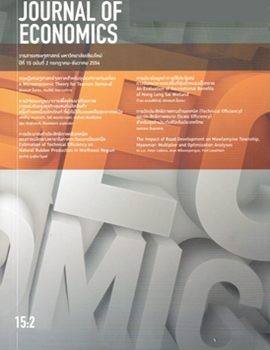การประมาณค่าประสิทธิภาพเชิงเทคนิคของการผลิตยางพาราใน ภาคตะวันออกเฉียงเหนือ
คำสำคัญ:
เส้นพรมแดนการผลิต, ประสิทธิภาพเชิงเทคนิค, ยางพารา, ภาคตะวันออกเฉียงเหนือ, production frontier, technical efficiency, rubber, northeast regionบทคัดย่อ
ในช่วง 2 ทศวรรษที่ผ่านมา ความต้องการใช้ยางพาราและราคายางมีแนวโน้มเพิ่มสูงขึ้นอย่างต่อเนื่อง เนื่องจากสภาพพื้นที่ๆเหมาะสมและต้นทุนการผลิตที่ต่่า รัฐบาลได้สนับสนุนให้มีการขยายพื้นที่ปลูกยางพาราในภาคตะวันออกเฉียงเหนือ อย่างไรก็ตาม ผลผลิตยางพาราต่อไร่ของภาคตะวันออกเฉียงเหนืออยู่ในเกณฑ์ต่่ากว่าภูมิภาคอื่นๆ งานวิจัยนี้ได้ประยุกต์ใช้แบบจาลองเส้นพรมแดนการผลิตเชิงเฟ้นสุ่มเพื่อวัดค่าประสิทธิภาพเชิงเทคนิคของเกษตรกรจานวน 450 ราย ครอบคลุมพื้นที่การผลิตยางพาราของภาคตะวันออกเฉียงเหนือทั้งตอนบน กลาง และล่าง และครอบคลุมยางในทุกช่วงอายุ ของปีการเพาะปลูก 2553 ผลการวิจัยพบว่าโดยเฉลี่ยแล้วเกษตรกรผู้ผลิตยางพาราในภาคตะวันออกเฉียงเหนือท่าการผลิตยางพาราเป็นไปอย่างไม่มีประสิทธิภาพ ซึ่งเกษตรกรสามารถเพิ่มผลผลิตยางพาราได้อีกประมาณ 33% จากปริมาณการใช้ปัจจัยการผลิต ณ ระดับปัจจุบัน โดยเกษตรกรในภาคตะวันออกเฉียงเหนือตอนบนและต้นยางที่มีอายุตั้งแต่ 18 ปีขึ้นไปแสดงค่าประสิทธิภาพเชิงเทคนิคสูงสุด จากผลการศึกษาพบว่าค่าประสิทธิภาพเชิงเทคนิคที่วัดได้มีค่าแตกต่างกันในแต่ละตอนของภาคและแตกต่างกันตามอายุของต้นยาง ดังนั้น การกาหนดนโยบายเพื่อเพิ่มประสิทธิภาพการผลิตยางพาราในภาคตะวันออกเฉียงเหนือไม่สามารถใช้นโยบายร่วมกัน (common policy) ของทั้งระดับภาคได้
Estimation of Technical Efficiency on Natural Rubber Production in Northeast Region
In the past two decades, global rubber consumption and prices tend to rise continuously. Due to suitable land planted rubber and low production costs, government had launched a project to expand areas for growing rubber trees in the Northeast region. However, yield per area of rubber is lower than other regions. This study employs a stochastic production frontier model to measure technical efficiency on natural rubber production in the Northeast region. Cross-section data of 450 rubber tree farms in 2010 are used in this study. Data cover farms located in the upper, middle and lower parts of the Northeast region and all ranges of the age of rubber trees. The findings show that the average technical efficiency score is 0.667 implying that the rubber farms in this study, on average, could possibly increase output by 33% given the same level of inputs. Farms located in the upper part of the region and old rubber trees indicate high technical efficiency scores. The findings also indicate that there are large differences in terms of technical efficiency scores in different regions and the age of rubber trees. Hence, common policy cannot be applied to improve technical efficiency in the Northeast region.
ดาวน์โหลด
ฉบับ
ประเภทบทความ
สัญญาอนุญาต
All opinions and contents in the CMJE are the responsibility of the author(s). Chiang Mai University Journal of Economics reserves the copyright for all published materials. Papers may not be reproduced in any form without the written permission from Chiang Mai University Journal of Economics.
ข้อคิดเห็นที่ปรากฏและแสดงในเนื้อหาบทความต่างๆในวารสารเศรษฐศาสตร์มหาวิทยาลัยเชียงใหม่ ถือเป็นความเห็นและความรับผิดชอบโดยตรงของผู้เขียนบทความนั้นๆ มิใช่เป็นความเห็นและความรับผิดชอบใดๆของวารสารเศรษฐศาสตร์ มหาวิทยาลัยเชียงใหม่
บทความ เนื้อหา และข้อมูล ฯลฯ ในวารสารเศรษฐศาสตร์มหาวิทยาลัยเชียงใหม่ ถือเป็นลิขสิทธิ์เฉพาะของคณะเศรษฐศาสตร์มหาวิทยาลัยเชียงใหม่ หากบุคคลหรือหน่วยงานใดต้องการนำทั้งหมดหรือส่วนหนึ่งส่วนใดไปเผยแพร่ต่อหรือเพื่อกระทำการใดๆ จะต้องได้รับอนุญาตเป็นลายลักษณ์อักษร จากวารสารเศรษฐศาสตร์ มหาวิทยาลัยเชียงใหม่






